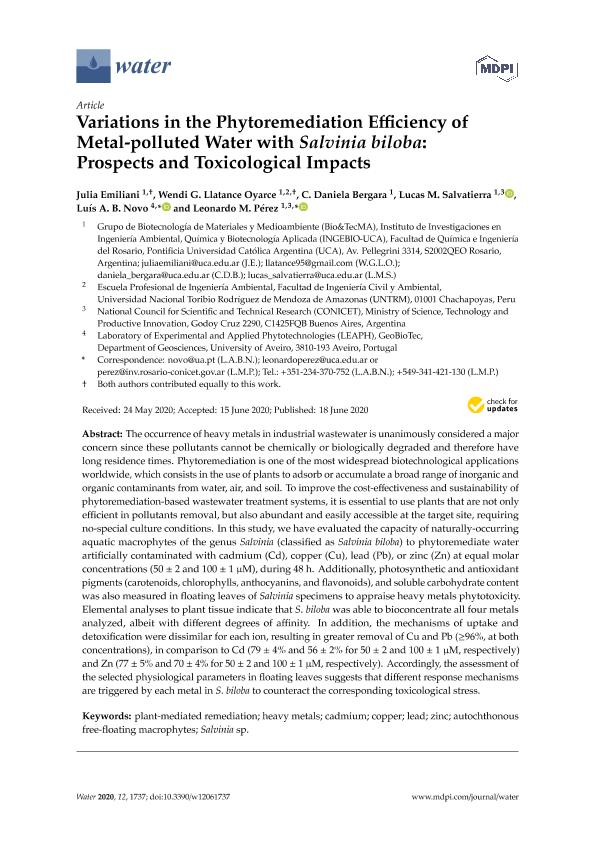Artículo
Variations in the Phytoremediation Efficiency of Metal-polluted Water with Salvinia biloba: Prospects and Toxicological Impacts
Emiliani, Julia ; Llatance Oyarce, Wendi G.; Bergara, Claudia Daniela; Salvatierra, Lucas Matías
; Llatance Oyarce, Wendi G.; Bergara, Claudia Daniela; Salvatierra, Lucas Matías ; Novo, Luís A. B.; Perez, Leonardo Martin
; Novo, Luís A. B.; Perez, Leonardo Martin
 ; Llatance Oyarce, Wendi G.; Bergara, Claudia Daniela; Salvatierra, Lucas Matías
; Llatance Oyarce, Wendi G.; Bergara, Claudia Daniela; Salvatierra, Lucas Matías ; Novo, Luís A. B.; Perez, Leonardo Martin
; Novo, Luís A. B.; Perez, Leonardo Martin
Fecha de publicación:
06/2020
Editorial:
MDPI AG
Revista:
Water
ISSN:
2073-4441
Idioma:
Inglés
Tipo de recurso:
Artículo publicado
Clasificación temática:
Resumen
The occurrence of heavy metals in industrial wastewater is unanimously considered a major concern since these pollutants cannot be chemically or biologically degraded and therefore have long residence times. Phytoremediation is one of the most widespread biotechnological applications worldwide, which consists in the use of plants to adsorb or accumulate a broad range of inorganic and organic contaminants from water, air, and soil. To improve the cost-effectiveness and sustainability of phytoremediation-based wastewater treatment systems, it is essential to use plants that are not only efficient in pollutants removal, but also abundant and easily accessible at the target site, requiring no-special culture conditions. In this study, we have evaluated the capacity of naturally-occurring aquatic macrophytes of the genus Salvinia (classified as Salvinia biloba) to phytoremediate water artificially contaminated with cadmium (Cd), copper (Cu), lead (Pb), or zinc (Zn) at equal molar concentrations (50 ± 2 and 100 ± 1 μM), during 48 h. Additionally, photosynthetic and antioxidant pigments (carotenoids, chlorophylls, anthocyanins, and flavonoids), and soluble carbohydrate content was also measured in floating leaves of Salvinia specimens to appraise heavy metals phytotoxicity. Elemental analyses to plant tissue indicate that S. biloba was able to bioconcentrate all four metals analyzed, albeit with different degrees of affinity. In addition, the mechanisms of uptake and detoxification were dissimilar for each ion, resulting in greater removal of Cu and Pb (≥96%, at both concentrations), in comparison to Cd (79 ± 4% and 56 ± 2% for 50 ± 2 and 100 ± 1 μM, respectively) and Zn (77 ± 5% and 70 ± 4% for 50 ± 2 and 100 ± 1 μM, respectively). Accordingly, the assessment of the selected physiological parameters in floating leaves suggests that different response mechanisms are triggered by each metal in S. biloba to counteract the corresponding toxicological stress.
Archivos asociados
Licencia
Identificadores
Colecciones
Articulos(CCT - ROSARIO)
Articulos de CTRO.CIENTIFICO TECNOL.CONICET - ROSARIO
Articulos de CTRO.CIENTIFICO TECNOL.CONICET - ROSARIO
Citación
Emiliani, Julia; Llatance Oyarce, Wendi G.; Bergara, Claudia Daniela; Salvatierra, Lucas Matías; Novo, Luís A. B.; et al.; Variations in the Phytoremediation Efficiency of Metal-polluted Water with Salvinia biloba: Prospects and Toxicological Impacts; MDPI AG; Water; 12; 6; 6-2020; 1-15
Compartir
Altmétricas



